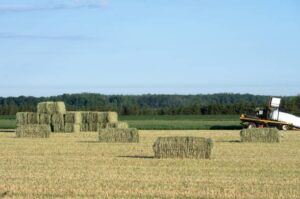Plastic wrapping of medium square bales helps preserve their quality while mitigating weather risk, saving storage costs in addition to improving weather protection.
McHale 998 bale wrap for square bales offers an in-cab control system to automate its wrapping cycle once bale dimensions and layer requirements have been entered into it. It can wrap 80 to 100 large square bales per hour on its trailed unit.
Choosing the Right Film
 Selecting an appropriate film for square bales is paramount to their preservation. After pre-stretching and overlapping the wrap, proper pre-stretch can ensure an airtight seal which minimises oxygen penetration which reduces forage loss due to oxygen penetration.
Selecting an appropriate film for square bales is paramount to their preservation. After pre-stretching and overlapping the wrap, proper pre-stretch can ensure an airtight seal which minimises oxygen penetration which reduces forage loss due to oxygen penetration.
Most wrappers include an operator manual table that will help determine how many layers of silage film will be necessary, depending on the moisture level of your crop and storage period. In general, longer storage requires more layers.
When purchasing silage film, ensure it contains UV stabilisers as a manufacturing step to minimise potential UV ray damage to its film material. This will limit any irreparable harm from occurring from sunlight exposure.
Some high-output wrappers are built to accommodate both round and square bales, enabling operators to adapt the machine according to harvest season conditions – helping save costs by not having to purchase separate machines for both types.
Layers of Film
KUHN also provides an in-line square bale wrapper using the same material used for our round bale wrapping service, giving producers fast and efficient ways to wrap square bales for silage or hay production. This high output wrapper can quickly cover square bales for silage or hay storage purposes.
The amount of film necessary for each bale varies based on its crop type and dry matter content. A higher layer count should generally be recommended for dryer bales due to sharper stems that could pierce through several layers of plastic and let moisture enter the bale.
For optimal results, the bale wrap for square bales must first be pre-stretched before being applied to a bale. To do this, mark two horizontal marks 10cm apart on the film reel, and measure their distance apart to see if your film has been stretched correctly – it ideally should be longer than this measurement to prevent any excess material dripping off and spoilage within your bale. According to research findings, total plastic thickness (rather than wrap count) appears more important in preventing oxygen diffusion and spoilage within bales than wrap counts alone
Bale Shape
Northern dairy regions have seen producers adopt medium square bales to streamline hay and haylage production and save time and labour costs. Because medium square bales require 2-3% less moisture at baling to prevent molding and heating, preservatives or plastic wrapping may be required to preserve them during storage.
Vermeer Net provides high-quality netwrap that improves bale shape and stability while helping maintain quality storage conditions for your hay. Furthermore, this form of protection offers superior weather or handling stress protection than twine.
Foster has designed and constructed various bale handling tools for large square bales that he and some of his clients continue to utilise in his modest shop and machine shed. Most recently he completed work on a front-end bale squeezer designed specifically for skid steers that gently handles wrapped bales without stretching them; hoping this piece of equipment may prove beneficial in helping those bale and stack silage themselves.
Storage
When it comes to storing wrapped square bales, oxygen exclusion is of utmost importance. Leakage of oxygen causes rapid degradation and mold growth if left to remain inside the bale; for this reason it’s critical that you select an adequate thickness of plastic film when selecting storage solutions.
Bale wrap for square bales with higher moisture contents (35% to 45%) require multiple layers of wrap to provide optimal fermentation conditions during storage, but lower moisture levels (35-36%), fermentation is minimal; oxygen should instead be excluded as much as possible from reaching inside.
Foster purchased his Kverneland model square bale wrapper in 1993 when few farmers were wrapping square bales. Now, however, up to 10,000 bales per month for farmers across southwest Wisconsin are wrapped by this modest shop and machine shed in his modest shop/machine shed he designed and built himself! Since he doesn’t farm any land himself but instead provides wrapped hay services directly to clients with convenience preferences he uses his equipment to serve.
